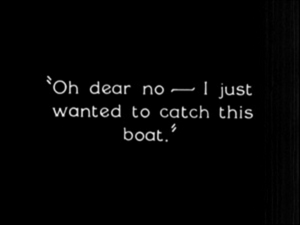
 Verity Hartley , Marketing Specialist, LanguageWire || Reading Time: 6 minutes
Verity Hartley , Marketing Specialist, LanguageWire || Reading Time: 6 minutes
If you have watched any form of video media over the last decade you will have likely encountered subtitling. From film and television, where they once started, to modern online video subtitles as an additional option for improving comprehension.
Subtitles are often added to the bottom of video content in what is known as the lower third of the screen. They are one to two lines of text used to describe the audio content that is taking place on screen at that time.
 Subtitles started with movies at the start of the 20th century and were first used in a movie called Uncle Tom's Cabin in 1903. At the start, they were called intertitles as they appeared between scenes to describe spoken dialogue in time before movies had soundtracks.
Subtitles started with movies at the start of the 20th century and were first used in a movie called Uncle Tom's Cabin in 1903. At the start, they were called intertitles as they appeared between scenes to describe spoken dialogue in time before movies had soundtracks.
Once audio tracks of the actor's voices were added to movies there began a need to make this new form of entertainment available to larger audiences globally. With the success of The Jazz Singer in 1927, the movie industry quickly released a French subtitled version in response to demands from a growing global audience. More language versions followed soon after and subtitling became mainstream.
This technology has continued to develop allowing movies to reach new audiences and grow box office profits across the globe. Subtitles are now used across a range of video mediums including film, television, video games and social media.
Subtitles are used to increase a viewer's accessibility to understanding the action unfolding onscreen.
They are needed for several reasons:
Subtitles are called captions when they provide an audio description of a video for those who are hard of hearing. They are a key tool for this community which would not be able to engage with your video content if you did not provide captions or a written transcript. The WHO reports that 20% of the global population has some form of hearing loss.
Additionally, consumers of your content may not have time available to view your video in a private setting and would therefore prefer to watch it on silent. A huge portion of short-form videos on social media and video platforms like YouTube are consumed this way. Facebook reports that 85% of videos on its platforms, including Instagram Reels, are watched on silent.
If you are not providing subtitles for the viewers of your video content, then you're preventing a large percentage of the global community from experiencing it. Subtitles are an essential part of your video production process.

An example of poor use of subtitling from the TV show Lost.
Subtitling is an art form. When done poorly they can reduce a viewer's comprehension of a video rather than support it. You have likely experienced subtitles that move too quickly on the screen or have poor visibility making it difficult to both read them and watch the live action take place.
A professional subtitler will adhere to several rules to get the perfect subtitling experience for the viewer.
The average viewer can read 70 characters or 12 words in four seconds. Any more characters than this and viewers will miss the end of the sentences. A subtitler has to consider not only how much text to show but also how long the text should dwell on the screen in order to sync up with the audio track. Do not try and force too many words onto the screen, you need to find a balance between the dwell time and the characters shown. You may be forced to make some difficult editing choices with your script in some cases.
If you are subtitling for multilingual audiences, you should not directly translate your original script. Some phrases, idioms and even numerical terms do not directly translate from one language to another and will sound unnatural to the reader.
Use the services of a language expert who can localize the text into something that translates naturally into another language. This may require some syncing adjustments in the subtitles as some phrases are longer in one language than another.
Consider the colour grading of your video. Is it very dark or very light? You need to adjust your subtitles so that they are readable when they are laid on top of your footage. Certain fonts and colours will become illegible when placed onto the video.
In most cases, white text on a black background in a standard non-serif font is used for subtitles. They are placed on the lower third of the screen so you also need to be aware that they may overlay any lower-third text boxes you have on your video, and you may need to edit your video accordingly.
Subtitling is not just for spoken words. If you show written text on the screen in your footage you may want to use on-screen captions to translate the words for multilingual viewers.
Similarly, if you are creating captions for hard-of-hearing or silent audiences you need to also translate sound effects and show them visibly so all audiences can get the full experience of your video.
If you are intending to share your videos with a global audience through social media or on your website, it is essential that you plan to add subtitles.
Whether you add them only in your source languages for accessibility or translate them into other languages for a broader reach, they will increase your audience engagement. If you want your content to be accessible to a larger global audience it is important that you develop a video localization plan, of which subtitling will play a part.
You can learn more about video localization and what is involved in our free download. Or if you would like to talk to someone further about how LanguageWire can help you with subtitles on your video content please fill out the form below and someone will be in touch to help.
Your journey to a powerful, seamless language management experience starts here! Tell us about your needs and we will tailor the perfect solution to your enterprise.